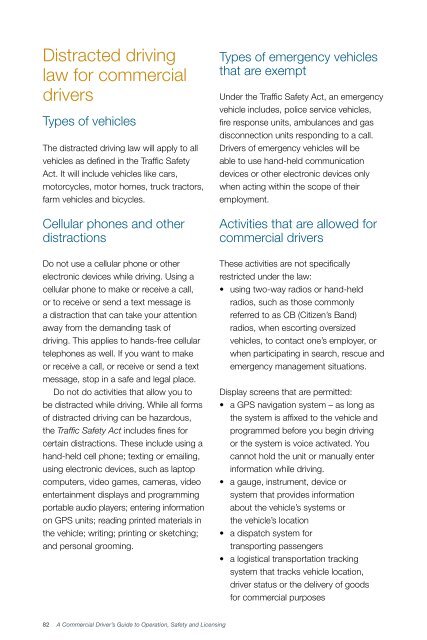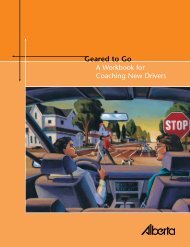Commercial driver's guide to operation, safety and licensing
Commercial driver's guide to operation, safety and licensing
Commercial driver's guide to operation, safety and licensing
Create successful ePaper yourself
Turn your PDF publications into a flip-book with our unique Google optimized e-Paper software.
Distracted driving<br />
law for commercial<br />
drivers<br />
Types of vehicles<br />
The distracted driving law will apply <strong>to</strong> all<br />
vehicles as defined in the Traffic Safety<br />
Act. It will include vehicles like cars,<br />
mo<strong>to</strong>rcycles, mo<strong>to</strong>r homes, truck trac<strong>to</strong>rs,<br />
farm vehicles <strong>and</strong> bicycles.<br />
Cellular phones <strong>and</strong> other<br />
distractions<br />
Do not use a cellular phone or other<br />
electronic devices while driving. Using a<br />
cellular phone <strong>to</strong> make or receive a call,<br />
or <strong>to</strong> receive or send a text message is<br />
a distraction that can take your attention<br />
away from the dem<strong>and</strong>ing task of<br />
driving. This applies <strong>to</strong> h<strong>and</strong>s-free cellular<br />
telephones as well. If you want <strong>to</strong> make<br />
or receive a call, or receive or send a text<br />
message, s<strong>to</strong>p in a safe <strong>and</strong> legal place.<br />
Do not do activities that allow you <strong>to</strong><br />
be distracted while driving. While all forms<br />
of distracted driving can be hazardous,<br />
the Traffic Safety Act includes fines for<br />
certain distractions. These include using a<br />
h<strong>and</strong>-held cell phone; texting or emailing,<br />
using electronic devices, such as lap<strong>to</strong>p<br />
computers, video games, cameras, video<br />
entertainment displays <strong>and</strong> programming<br />
portable audio players; entering information<br />
on GPS units; reading printed materials in<br />
the vehicle; writing; printing or sketching;<br />
<strong>and</strong> personal grooming.<br />
Types of emergency vehicles<br />
that are exempt<br />
Under the Traffic Safety Act, an emergency<br />
vehicle includes, police service vehicles,<br />
fire response units, ambulances <strong>and</strong> gas<br />
disconnection units responding <strong>to</strong> a call.<br />
Drivers of emergency vehicles will be<br />
able <strong>to</strong> use h<strong>and</strong>-held communication<br />
devices or other electronic devices only<br />
when acting within the scope of their<br />
employment.<br />
Activities that are allowed for<br />
commercial drivers<br />
These activities are not specifically<br />
restricted under the law:<br />
• using two-way radios or h<strong>and</strong>-held<br />
radios, such as those commonly<br />
referred <strong>to</strong> as CB (Citizen’s B<strong>and</strong>)<br />
radios, when escorting oversized<br />
vehicles, <strong>to</strong> contact one’s employer, or<br />
when participating in search, rescue <strong>and</strong><br />
emergency management situations.<br />
Display screens that are permitted:<br />
• a GPS navigation system – as long as<br />
the system is affixed <strong>to</strong> the vehicle <strong>and</strong><br />
programmed before you begin driving<br />
or the system is voice activated. You<br />
cannot hold the unit or manually enter<br />
information while driving.<br />
• a gauge, instrument, device or<br />
system that provides information<br />
about the vehicle’s systems or<br />
the vehicle’s location<br />
• a dispatch system for<br />
transporting passengers<br />
• a logistical transportation tracking<br />
system that tracks vehicle location,<br />
driver status or the delivery of goods<br />
for commercial purposes<br />
82 A <strong>Commercial</strong> Driver’s Guide <strong>to</strong> Operation, Safety <strong>and</strong> Licensing




